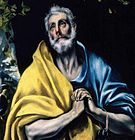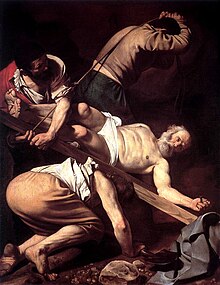
Barnabas, born Joseph (Ἰωσήφ) or Joses (Ἰωσής), was according to tradition an early Christian, one of the prominent Christian disciples in Jerusalem. According to Acts 4:36, Barnabas was a Cypriot Jew. Named an apostle in Acts 14:14, he and Paul the Apostle undertook missionary journeys together and defended Gentile converts against the Judaizers. They traveled together making more converts, and participated in the Council of Jerusalem. Barnabas and Paul successfully evangelized among the "God-fearing" Gentiles who attended synagogues in various Hellenized cities of Anatolia.
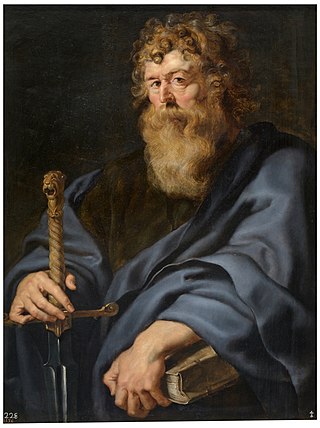
Paul, commonly known as Paul the Apostle and Saint Paul, was a Christian apostle who spread the teachings of Jesus in the first-century world. For his contributions towards the New Testament, he is generally regarded as one of the most important figures of the Apostolic Age, and he also founded several Christian communities in Asia Minor and Europe from the mid-40s to the mid-50s AD.

Polycarp was a Christian bishop of Smyrna. According to the Martyrdom of Polycarp, he died a martyr, bound and burned at the stake, then stabbed when the fire failed to consume his body. Polycarp is regarded as a saint and Church Father in the Catholic Church, Eastern Orthodox Church, Oriental Orthodox Churches, Lutheranism, and Anglicanism.
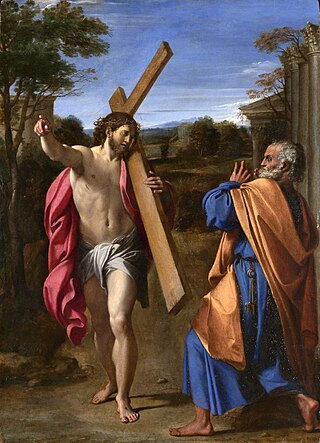
Quo vadis? is a Latin phrase meaning "Where are you going?" It is commonly translated, quoting the KJV translation of John 13:36, as "Whither goest thou?"

John the Apostle, also known as Saint John the Beloved and, in Eastern Orthodox Christianity, Saint John the Theologian, was one of the Twelve Apostles of Jesus according to the New Testament. Generally listed as the youngest apostle, he was the son of Zebedee and Salome. His brother James was another of the Twelve Apostles. The Church Fathers identify him as John the Evangelist, John of Patmos, John the Elder, and the Beloved Disciple, and testify that he outlived the remaining apostles and was the only one to die of natural causes, although modern scholars are divided on the veracity of these claims.
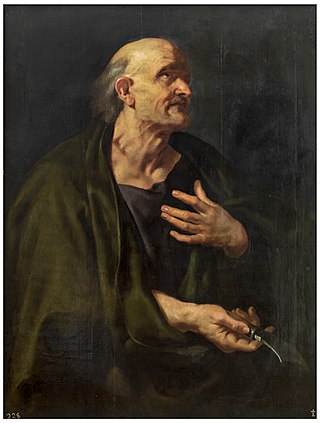
Bartholomew was one of the twelve apostles of Jesus according to the New Testament. Most scholars today identify Bartholomew as Nathanael or Nathaniel, who appears in the Gospel of John.
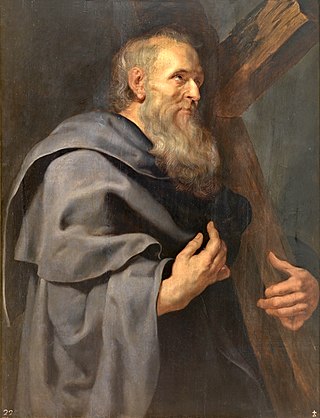
Philip the Apostle was one of the Twelve Apostles of Jesus according to the New Testament. Later Christian traditions describe Philip as the apostle who preached in Greece, Syria, and Asia-Minor.

The Acts of Peter is one of the earliest of the apocryphal Acts of the Apostles in Christianity, dating to the late 2nd century AD. The majority of the text has survived only in the Latin translation of the Codex Vercellensis, under the title Actus Petri cum Simone. It is notable for a description of a miracle contest between Saint Peter and Simon Magus, the first record of the tradition that Saint Peter was crucified head-down, and as the origin of the saying Quo vadis?

The Acts of Andrew, is a Christian apocryphal work describing acts and miracles of Andrew the Apostle. It is alluded to in a Coptic 3rd-century work titled the Manichaean Psalm Book, so it must have been composed prior to that century. By the 4th century, the stories told in the book were considered apocryphal, and the book was relegated to the New Testament apocrypha.

In Christianity, the Lord's Day refers to Sunday, the principal day of communal worship. It is the first day of the week in the Hebrew calendar and traditional Christian calendars, with the exception of European (workweek) calendars. It is observed by most Christians as the weekly memorial of the resurrection of Jesus Christ, who is said to have been raised from the dead early on the first day of the week. The phrase appears only once in Rev. 1:10 of the New Testament.

The Crucifixion of Saint Peter is a work by Michelangelo Merisi da Caravaggio, painted in 1601 for the Cerasi Chapel of Santa Maria del Popolo in Rome. Across the chapel is a second Caravaggio work depicting the Conversion of Saint Paul on the Road to Damascus (1601). On the altar between the two is the Assumption of the Virgin Mary by Annibale Carracci.

Domine, quo vadis? is a 1602 painting by the Italian Baroque painter Annibale Carracci (1560–1609), depicting a scene from the apocryphal Acts of Peter. It is housed in the National Gallery, where it is given the title Christ appearing to Saint Peter on the Appian Way. The subject is a rare representation in art of the theme Quo vadis. Annibale Carracci was the founder of the Italian Baroque painting school, called Bolognese School. This painting is one of his best known works. Peter is depicted fleeing Rome to avoid crucifixion and has a vision of meeting Christ bearing his Cross. Peter asks Jesus "Quo vadis?" to which he replies, "Romam vado iterum crucifigi". Peter returns to Rome after this vision.

The Acts of the Apostles is a genre of early Christian literature, recounting the lives and works of the apostles of Jesus. The Acts are important for many reasons, one of them being the concept of apostolic succession. They also provide insight into the valuation of "missionary activities among the exotic races," since some of them feature missionary work done among, for instance, the Cynocephaly.

Andrew the Apostle, also called Saint Andrew, was an apostle of Jesus. According to the New Testament, he was a fisherman and one of the Twelve Apostles chosen by Jesus. The title First-Called stems from the Gospel of John, where Andrew, initially a disciple of John the Baptist, follows Jesus and, recognizing him as the Messiah, introduces his brother Simon Peter to him.

Saint Peter, also known as Peter the Apostle, Simon Peter, Simeon, Simon, or Cephas, was one of the Twelve Apostles of Jesus Christ and one of the first leaders of the early Christian Church. He appears repeatedly and prominently in all four New Testament gospels as well as the Acts of the Apostles. Catholic tradition accredits Peter as the first bishop of Rome—or pope—and also as the first bishop of Antioch.

The Restoration of Peter is an incident described in John 21 of the New Testament in which Jesus appeared to his disciples after his resurrection and spoke to Peter in particular. Jesus restored Peter to fellowship after Peter had previously denied him and told Peter to feed Jesus' sheep.

Jordan Terrell Cartera, known professionally as Playboi Carti, is an American rapper and record producer. An influential figure among his generation, he has contributed to the progression of trap music and its rage subgenre. He first signed with local underground record label Awful Records in 2014, and later signed with ASAP Mob's record label AWGE, in a joint venture with Interscope Records two years later. Carter gained mainstream attention following the release of his eponymous debut mixtape (2017), which peaked at number 12 on the US Billboard 200 and spawned the Billboard Hot 100-charting singles "Magnolia" and "Wokeuplikethis".
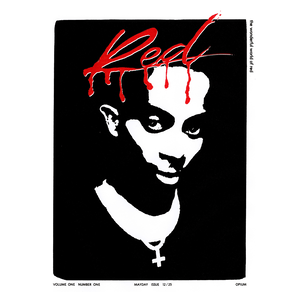
Whole Lotta Red is the second studio album by American rapper Playboi Carti. It was released through AWGE and Interscope Records on December 25, 2020. Production was executively handled by Kanye West, who appears on the song "Go2DaMoon" and was primarily handled by F1lthy and Art Dealer alongside several other record producers, including Pi'erre Bourne, Maaly Raw, Lil 88, Ken Carson and Wheezy. The album consists of 24 tracks and features guest appearances from Kid Cudi, Future and Kanye West. Work on the album commenced in late 2018 and concluded in November 2020. The album serves as a follow-up to his debut studio album, Die Lit (2018).

Crucifixion of Saint Andrew is a tempera painting by Greek painter Michael Damaskinos. Damaskinos painted in Heraklion, Venice, Sicily, and other parts of Italy. He was associated with the Greek church San Giorgio dei Greci in Venice. His painting of the Crucifixion of Saint Andrew follows the traditional Greek mannerisms prevalent at the time. It is a rare painting of Andrew the Apostle crucified in the same style as his brother Saint Peter. Saint Peter refused to be crucified the same way as Jesus. He was crucified upside down. Saint Andrew is typically crucified in the form of an X rather than the cross. He was crucified in Patras where his remains can be found today at the Cathedral of Saint Andrew, Patras. The Damaskinos painting of the Crucifixion of Saint Andrew can be found at the Byzantine and Christian Museum in Athens, Greece.
Opium is an American record label and rap collective that was founded in 2019 by American rapper Playboi Carti. The label, which is based in Atlanta, Georgia, currently holds four acts all of whom are natives to the city; Playboi Carti himself, rappers Ken Carson and Destroy Lonely, and the duo Homixide Gang. The label is also affiliated with a variety of producers including KP Beatz, F1lthy, and Art Dealer, who all worked extensively on Playboi Carti's second studio album, Whole Lotta Red.

